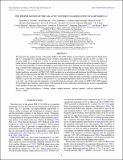| dc.contributor.author | Bower, Geoffrey C. | |
| dc.contributor.author | Deller, Adam | |
| dc.contributor.author | Demorest, Paul | |
| dc.contributor.author | Brunthaler, Andreas | |
| dc.contributor.author | Falcke, Heino | |
| dc.contributor.author | Moscibrodzka, Monika | |
| dc.contributor.author | O'Leary, Ryan M. | |
| dc.contributor.author | Eatough, Ralph P. | |
| dc.contributor.author | Kramer, Michael | |
| dc.contributor.author | Lee, K. J. | |
| dc.contributor.author | Spitler, Laura | |
| dc.contributor.author | Desvignes, Gregory | |
| dc.contributor.author | Rushton, Anthony P. | |
| dc.contributor.author | Reid, Mark J. | |
| dc.contributor.author | Doeleman, Sheperd Samuel | |
| dc.date.accessioned | 2015-02-20T16:40:23Z | |
| dc.date.available | 2015-02-20T16:40:23Z | |
| dc.date.issued | 2015-01 | |
| dc.date.submitted | 2014-08 | |
| dc.identifier.issn | 1538-4357 | |
| dc.identifier.issn | 0004-637X | |
| dc.identifier.uri | http://hdl.handle.net/1721.1/95444 | |
| dc.description.abstract | We measure the proper motion of the pulsar PSR J1745-2900 relative to the Galactic center massive black hole, Sgr A*, using the Very Long Baseline Array (VLBA). The pulsar has a transverse velocity of 236 ± 11 km s[superscript –1] at position angle 22 ± 2 deg east of north at a projected separation of 0.097 pc from Sgr A*. Given the unknown radial velocity, this transverse velocity measurement does not conclusively prove that the pulsar is bound to Sgr A*; however, the probability of chance alignment is very small. We do show that the velocity and position are consistent with a bound orbit originating in the clockwise disk of massive stars orbiting Sgr A* and a natal velocity kick of [< over ~] 500 km s[superscript –1]. An origin among the isotropic stellar cluster is possible but less probable. If the pulsar remains radio-bright, multiyear astrometry of PSR J1745-2900 can detect its acceleration and determine the full three-dimensional orbit. We also demonstrate that PSR J1745-2900 exhibits the same angular broadening as Sgr A* over a wavelength range of 3.6 cm to 0.7 cm, further confirming that the two sources share the same interstellar scattering properties. Finally, we place the first limits on the presence of a wavelength-dependent shift in the position of Sgr A*, i.e., the core shift, one of the expected properties of optically thick jet emission. Our results for PSR J1745-2900 support the hypothesis that Galactic center pulsars will originate from the stellar disk and deepen the mystery regarding the small number of detected Galactic center pulsars. | en_US |
| dc.language.iso | en_US | |
| dc.publisher | IOP Publishing | en_US |
| dc.relation.isversionof | http://dx.doi.org/10.1088/0004-637X/798/2/120 | en_US |
| dc.rights | Article is made available in accordance with the publisher's policy and may be subject to US copyright law. Please refer to the publisher's site for terms of use. | en_US |
| dc.source | American Astronomical Society | en_US |
| dc.title | THE PROPER MOTION OF THE GALACTIC CENTER PULSAR RELATIVE TO SAGITTARIUS A* | en_US |
| dc.type | Article | en_US |
| dc.identifier.citation | Bower, Geoffrey C., Adam Deller, Paul Demorest, Andreas Brunthaler, Heino Falcke, Monika Moscibrodzka, Ryan M. O’Leary, et al. “THE PROPER MOTION OF THE GALACTIC CENTER PULSAR RELATIVE TO SAGITTARIUS A*.” The Astrophysical Journal 798, no. 2 (January 8, 2015): 120. © 2015 The American Astronomical Society | en_US |
| dc.contributor.department | Haystack Observatory | en_US |
| dc.contributor.mitauthor | Doeleman, Sheperd Samuel | en_US |
| dc.relation.journal | The Astrophysical Journal | en_US |
| dc.eprint.version | Final published version | en_US |
| dc.type.uri | http://purl.org/eprint/type/JournalArticle | en_US |
| eprint.status | http://purl.org/eprint/status/PeerReviewed | en_US |
| dspace.orderedauthors | Bower, Geoffrey C.; Deller, Adam; Demorest, Paul; Brunthaler, Andreas; Falcke, Heino; Moscibrodzka, Monika; O'Leary, Ryan M.; Eatough, Ralph P.; Kramer, Michael; Lee, K. J.; Spitler, Laura; Desvignes, Gregory; Rushton, Anthony P.; Doeleman, Sheperd; Reid, Mark J. | en_US |
| mit.license | PUBLISHER_POLICY | en_US |
| mit.metadata.status | Complete | |
